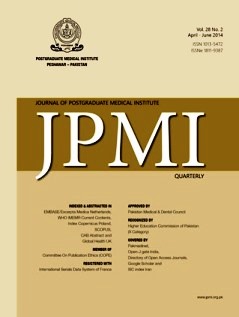Risk factors of preterm labour and the use of progesterone in prevention of preterm birth
Main Article Content
Abstract
Objective: To find out the risk factors of preterm labour and to study the useof progesterone for the prevention of preterm birth.Methodology: An interventional study was conducted for a period of oneyear on patients admitted with threatened preterm labour. The outcome measuresincluded preterm birth at less than 37 completed weeks of gestation,fetal and neonatal outcome. The patients were started on two injections of250 mg hydroxyprogesterone daily for the first 3 days. They were dischargedon two injections (250 mg each) at three days interval for 2 weeks and wereinvited for a follow-up visit in antenatal clinics.Results: Out of 4670 pregnant women with singleton pregnancy, 567 (12.14%)presented with confirmed preterm labour. Risk factors for spontaneouspreterm labour included maternal age less than 25 years (n=367, 64.67%),history of preterm birth (n=236, 41.62%), uterine anomalies (n=23, 4.06%) andcervical anomalies (n=4, 0.71%). Injectable Progesterone was associated witharrest of early labour pains and prolongation of pregnancy. Neonatal outcomeincluding respiratory distress syndrome (n=23, 4.06%), necrotizing enterocolitis(n=4, 0.71%) and admission to neonatal Intensive Care Unit (n=6, 1.06%)were noted. Due to beneficial effects of Injectable progesterone, the pregnancywas observed to be prolonged by 4 or more than 4 weeks (n=405, 71.43%).Conclusion: Preterm birth can be prevented if risk factors of preterm labourare fully assessed and managed properly. Progesterone is associated withbeneficial effects in prolonging pregnancy and preventing preterm delivery.
Article Details
How to Cite
1.
Farooq S. Risk factors of preterm labour and the use of progesterone in prevention of preterm birth. J Postgrad Med Inst [Internet]. 2014 Apr. 17 [cited 2025 Dec. 13];28(2). Available from: https://jpmi.org.pk/index.php/jpmi/article/view/1404
Issue
Section
Original Article
Work published in JPMI is licensed under a
Creative Commons Attribution-NonCommercial 2.0 Generic License.
Authors are permitted and encouraged to post their work online (e.g., in institutional repositories or on their website) prior to and during the submission process, as it can lead to productive exchanges, as well as earlier and greater citation of published work.


